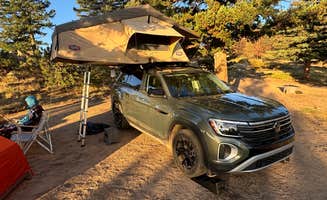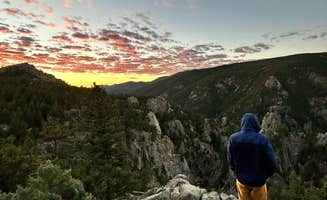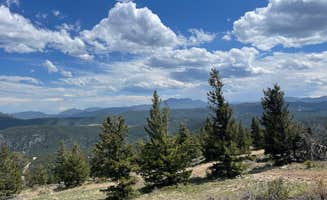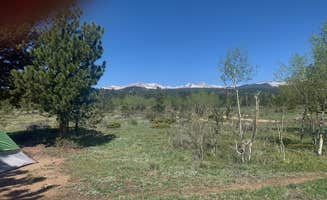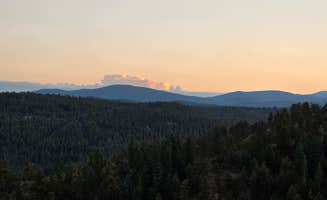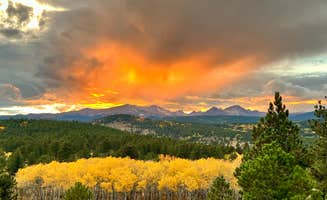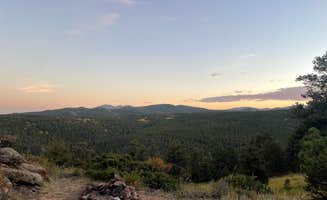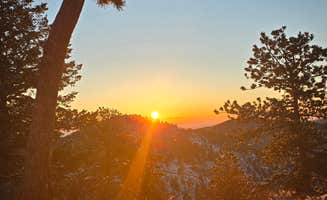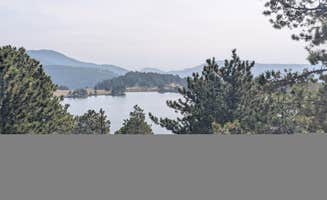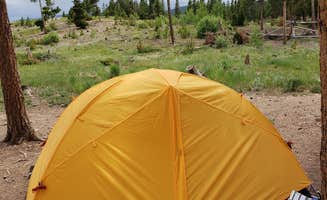Rustic camping near Superior, Colorado offers primitive sites scattered across Roosevelt National Forest at elevations typically between 8,000-11,000 feet. Most accessible camping options lie within a 30-45 minute drive, concentrated in forested areas near Nederland, Ward, and Allenspark. Fire restrictions frequently apply during summer months, with overnight temperatures often dropping below 40°F even in July and August due to the high elevation.
What to do
Creek exploration: North Boulder Creek Dispersed Camping offers access to scenic water features. As one camper notes, "there are mountains and aspen forests, and wildflowers everywhere! I also saw elk nearby." The creek areas provide natural cooling during summer months when temperatures can exceed 80°F during daytime hours.
Mountain biking: West Magnolia Campground connects to extensive trail systems. "Great location with single tracks for hiking and mountain biking. Camping spots are well-marked," reports a recent visitor. The interconnected trails vary in difficulty, with most intermediate trails requiring 1-3 hours to complete.
Wildlife watching: Dawn and dusk provide optimal viewing opportunities for native species. "Moose visitors at dawn and evening, and hungry bears scavenging for food at night is a common occurrence," shares one camper about their experience. Remember that wildlife should never be approached or fed, and all food must be properly secured overnight.
What campers like
Proximity to towns: Most dispersed sites allow quick access to nearby communities for supplies. "This was a close 1 night get away spot. Pretty area, the sites we saw were numbered... Nederland is close enough to run into town if needed," explains one camper at Gordon Gulch Dispersed Area.
Stargazing opportunities: Areas farther from Boulder provide darker skies. "Went to this location to get dark sky to see the Perseid meteor shower. Views were great. Nice and quiet," reports a visitor to North Boulder Creek. The best viewing occurs after 10 PM when light pollution is minimized.
Creek-adjacent sites: Allenspark Dispersed Camping features water-side camping. "Lots of spots available. Just keep driving along Ski Road and pick one that looks good. Lots of fire pits already built and most camp spots are along the creek," explains a regular visitor. Water noise helps mask road sounds and creates natural white noise for sleeping.
What you should know
Road conditions vary seasonally: Many access roads deteriorate quickly after rain or snow. "The road was pretty mild but on up gets a lot more rough! The pull offs are great and most of them have fire rings," notes a camper at Allenspark. Spring conditions typically worsen after snowmelt through May.
Wildlife precautions required: Bear activity is common throughout the region. "The second day staying there we ran into a bear and scared him off. Two hours later he came back and we scared him off again. He's afraid of humans but he did try to get into the car while we were sleeping," warns an Allenspark camper.
Limited facilities: None of the dispersed areas provide amenities. "There is no water or toilets or garbage receptacles, so leave no trace principles apply," explains a camper at Dream Canyon Campsites. Pack out all trash and plan to carry sufficient water for your stay.
Tips for camping with families
Choose sites with natural barriers: Areas with trees or rocks provide boundaries for children. "We camped a very short walk from the parking lot. Amazing camp site with not many people around," shares a visitor to Dream Canyon. Natural features help define safe play areas for younger campers.
Plan for temperature swings: Night temperatures drop significantly even in summer. "It got a bit chilly at night but not too bad," notes a camper at North Boulder Creek. Pack additional layers as temperatures can vary by 30-40°F between day and night.
Consider noise factors: Some sites experience significant vehicle traffic. "It's right next to 72, so traffic sounds, and there's 4 wheelers and dirt bikes, so not exactly quiet," explains a camper at Gordon Gulch. Sites farther from main roads generally offer quieter experiences.
Tips from RVers
Scout sites before committing: Many areas have limited turnaround space. "The road passing through lots of private property, which can trick you into thinking you're driving down the wrong road. The trailhead parking lot has one giant rut that you must be careful to navigate around," advises a visitor to Dream Canyon.
Length limitations: Beaver Park Reservoir accommodates some larger vehicles. "Beautiful lake with several good sized RV spots. We have a 25 foot camper and fit nicely in. Road in was good as well," shares a camper who visited in spring. Most dispersed sites limit practical vehicle length to under 30 feet.
Clearance requirements: Low-clearance vehicles face significant challenges. "Going up past site 6 is a steep hill where 4x4 is highly recommended. We ended up turning around there but probably could have made it if I picked a good line," explains a visitor at Gross Reservoir Dispersed.


